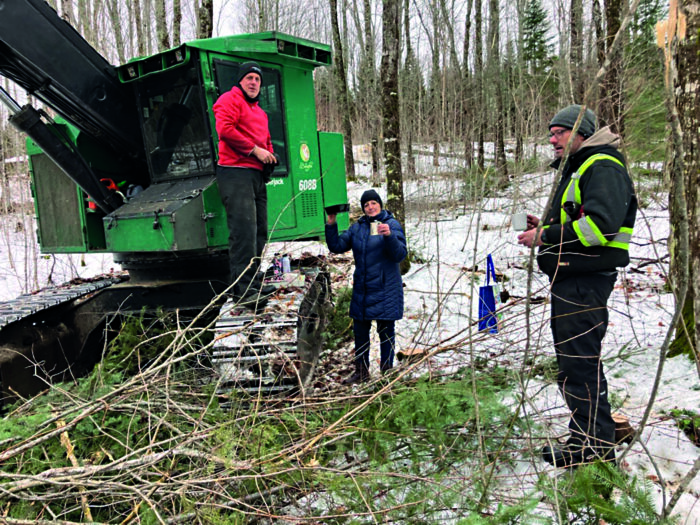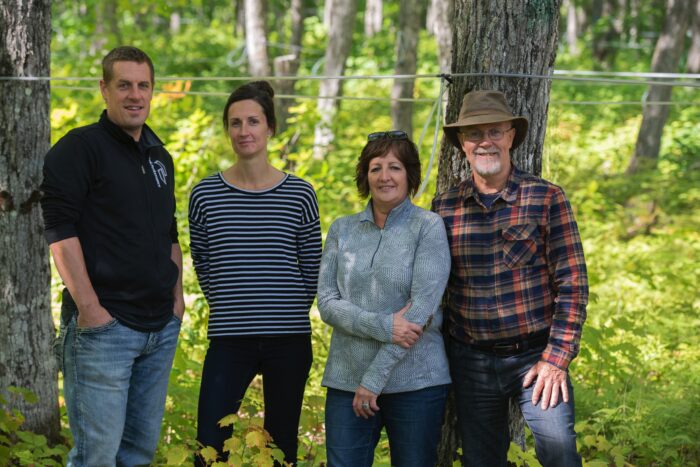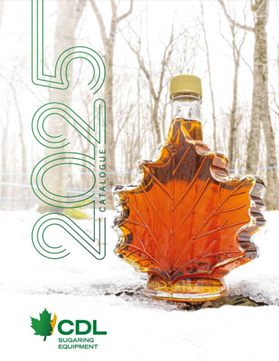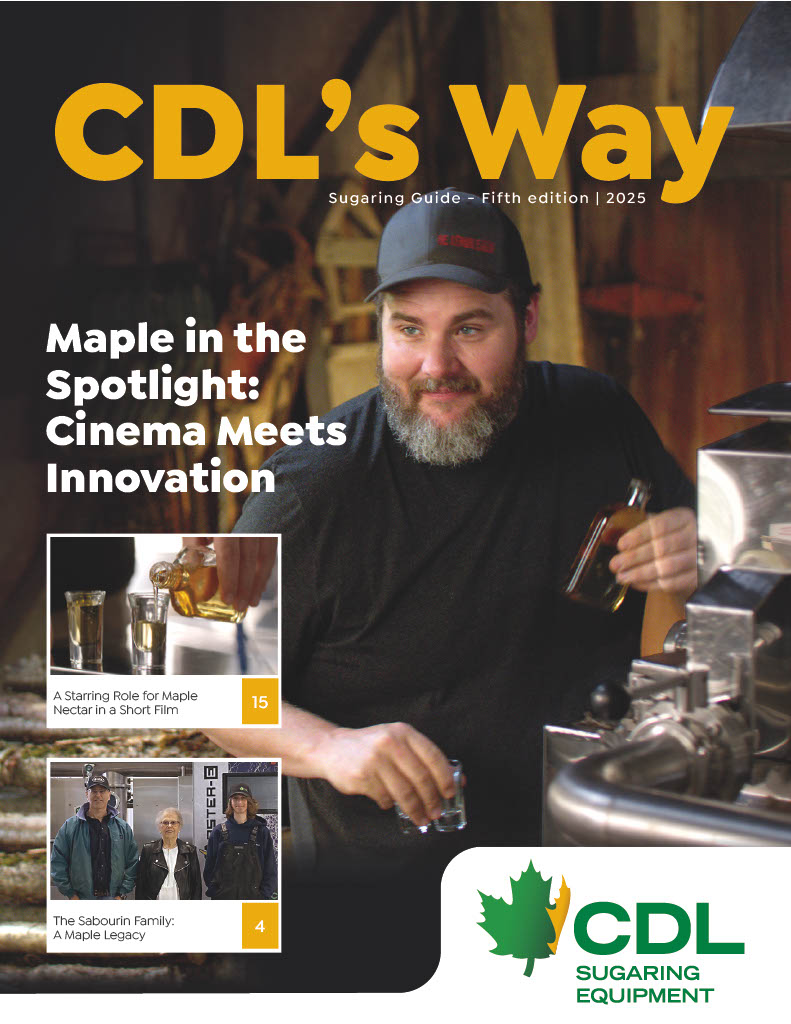Securing the Future of Sugar Bushes: 5 Key Principles to Know
In maple syrup production, we often talk about syrup quality, equipment performance, and market challenges. However, sustainable forest management is just as essential. So I asked myself: how can we maintain the health of a sugar bush, avoid common mistakes, and adapt practices in the face of environmental change?
To better understand these issues, I spoke with Jeannot Beaulieu, forester, experienced maple syrup producer, and recipient of the Provincial Forestry Merit award in 1993 and 2013 for the Bas-Saint-Laurent region. For over 40 years, he has implemented thoughtful strategies for the stewardship of his sugar bush. Sitting in his sugar shack, we discussed essential practices to ensure the longevity of this precious resource.

Jeannot and his family at the presentation of the Provincial Forestry Merit Award
Jeannot Beaulieu is a true craftsman of the forest, having built a legacy that is both sustainable and inspiring. Honored with the Provincial Forestry Merit award, a distinction recognizing exceptional commitment to forest management and sustainable development, Jeannot has combined expertise and vision through exemplary management of his forest properties. With over 1,300 hectares of forest and a sugar bush with 44,000 taps, he embodies the balance between responsible exploitation and knowledge transmission.
1. ENCOURAGE SUGAR BUSH REGENERATION
“A sugar bush is an ecosystem that evolves with or without us,” Jeannot emphasizes. As producers, we wound our maple trees every year when tapping. Contrary to popular belief, letting a forest grow naturally does not ensure its longevity. Trees must be kept in optimal growth to heal quickly from the annual tapping wounds. Without proper management, overcrowded stands intensify competition for resources like light and nutrients. When competition among maples increases, their growth potential is limited. Many studies show a direct link between tree size and sap yield per tap.
Maximizing growth each year can therefore increase the amount of sap per tap. Since 1985, to ensure optimal growth of his maples, Jeannot has practiced targeted thinning according to his forest’s needs. He observed that while the total number of trees may decrease, the remaining ones grow stronger, healthier, and more productive.
2. RECOGNIZE WHEN INTERVENTION IS NEEDED
How do you know if your sugar bush needs intervention? Jeannot recommends looking for these indicators:
- Excessive density: When trees are too close together, growth slows and vigor decreases due to competition for light and nutrients.
- Poor healing of tapping holes: A healthy maple tree closes its old tap holes within a few years. If not, it’s a sign of poor growth. A 1/4” spout hole should close by the following year if the tree is growing well.
Jeannot also points out that forest management is a daily effort. When heading into the woods, he always brings a small pruner. Whenever he spots a young maple, he takes time to observe and select one to favor. He then trims a few branches to ensure a future tapping area free of defects. Pruning early ensures a high-quality tap tree later on.
3. INTERVENE AT THE RIGHT TIME
The timing of forest operations is just as critical as the method. Ideally, interventions should occur between October and February to minimize the impact on the sugar bush. In summer, maples are actively growing and their bark is more fragile, making them more vulnerable to injury, infection, and disease. Additionally, soft and moist soil can be compacted by machinery, harming root development and forest regeneration.
Conversely, in winter, frozen ground and snow cover help protect the forest by cushioning the impact of forestry equipment, reducing damage to soil and saplings.
Smartly planning forestry work helps preserve maple tree health, promotes regeneration, and optimizes the sugar bush’s quality and longevity.

The Beaulieu family in action in the forest
4. MAINTAIN SPECIES DIVERSITY
To preserve a sugar bush’s resilience, it’s important to maintain companion species such as yellow birch and ash. These trees play a key role in forest balance and biodiversity:
- Yellow birch enhances soil diversity and regenerates well in mineral soils.
- Ash, found in wet areas, stabilizes the environment and supports maple growth.
Official guidelines recommend maintaining 10–15% of companion species in a managed sugar bush to reduce the risk of maple-specific diseases and strengthen the forest’s natural balance.
5. CUT SMART
“Before cutting a tree, ask yourself why you’re cutting it,” Jeannot insists, reminding us that forest management should not be driven by short-term gain, but by the long-term sustainability of the sugar bush. He now favors selective cutting, removing only harmful or unbalanced trees. He shared a story about cutting down a two-foot diameter maple. Fellow producers who saw it asked, “Jeannot, are you depressed?” He simply explained that if he didn’t cut that tree, the five beautiful young maples around it would die. He chose to favor those five trees over one, ensuring the sugar bush’s future.
This approach promotes optimal growth for remaining trees and sustainable syrup production over time.

Jeannot, accompanied by his wife Marjolaine, his son Yvan, and his daughter Weena
PRESERVING THE SUGAR BUSH FOR FUTURE GENERATIONS
“What we do today in a sugar bush isn’t for us, but for those who come after us.” This reflection sums up the mindset Jeannot Beaulieu wants to pass on to his children and grandchildren.
Managing a sugar bush is not just about maximizing a single year’s harvest, it’s a long-term commitment to maintaining a healthy, productive ecosystem for generations to come.
“The forest doesn’t belong to us; it belongs to future generations. We are cultivating our children’s forest today.”
1 : Rademacher, T. (2023). Les pratiques durables en acériculture : études, observations et réflexion pour des réponses éclairées. Producteurs et productrices acéricoles du Québec. https:/ppaq.ca/fr/blogue/les-pratiques-durables-en-acericulture-etudesobservations-et-reflexion-pour-des-reponses-eclairees/


